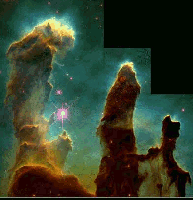|
IX. ORIGIN OF STARS AND THEIR LIFE HISTORIES
All the Hydrogen and some of the Helium in our universe were condensed
from the primordial radiation universe shortly after the Big Bang. How
did all the other 90 some-odd elements come to be? How does a cloud of
hydrogen and helium change into all the wondrous stars and galaxies we
see today?
The answer is that these other elements formed by fusion in stellar
furnaces. It is supernovae (exploding stars) that both create elements
heavier than Iron and release all elements back into space where they become
mixed with the surrounding galactic material (mainly Hydrogen and Helium)
and thereby enrich it in heavier elements. Our own solar system is but
one of these hundreds of billions of systems that have formed in the Milky
Way galaxy from materials enriched by neighboring supernova explosions.
A. Formation of interstellar clouds (Nebulae).
In our galaxy, there are large amounts of uncompressed gas and dust,
nebulae, that form large clouds tens (10-50) of LY across of variable
mass. Small nebulae may only have a fraction of a solar mass. One such,
the Orion Nebula that can be seen with the naked eye in the Orion Constellation,
includes some 10,000 solar masses. Others may have masses of millions of
solar masses. These are the clouds that eventually will form new
star systems. So why would these clouds hang around for billions of years
and then suddenly form star systems?
There are several possibilities how these nebulae will compress to become
star formation sites:
-
when colliding galaxiesí gravitational fields disturb the gases
-
when these clouds collide along the edge of a spiral arm, and
-
when nearby supernovae (exploding stars) eject materials and the shock
of these ejected materials colliding with the nebulae initiates contraction.
 The first step in star
formation is the formation of an opaque cloud of gas; in other words as
the Hydrogen and Helium become denser, they increasingly block the passage
of EM radiation and therefore appear dark. During this initial contraction,
chemical reactions between the atoms of gases take place, and various molecules
such as water, ammonia, silicon oxide, formaldehyde, methanol and many
more are formed. All told, nearly one hundred of these molecules have been
detected in nebulae, many of them organic molecules. The first step in star
formation is the formation of an opaque cloud of gas; in other words as
the Hydrogen and Helium become denser, they increasingly block the passage
of EM radiation and therefore appear dark. During this initial contraction,
chemical reactions between the atoms of gases take place, and various molecules
such as water, ammonia, silicon oxide, formaldehyde, methanol and many
more are formed. All told, nearly one hundred of these molecules have been
detected in nebulae, many of them organic molecules.
As compression continues, the size of the nebula decreases, while gravity
and density continue to increase. The contraction process however is not
evenly spread throughout the nebula. In some parts of the nebula, there
are areas where the gas and dust are more compressed than other areas,
called clumps. |





